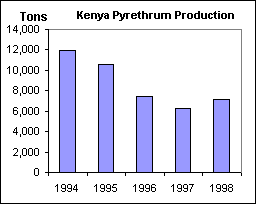






















|
Pyrethrum
Research shows that pyrethrum based pesticides
can have serious side effects to humans. The information
below was never meant to suggest that it be repeatedly
applied to humans by way of a mister system for mosquito control, or applied in a way
that the product could come into contact with food meant
for humans. Serious genetic and neurological damage can occur
to humans through repeated exposure. Pyrethrums/ Pyrethroids are some of
the least toxic pesticides to humans, but can cause damage when applied
through a misting system. Pyrethrum is very effective in controlling mosquitoes, ants,
flies, crickets, fleas, and wasps.
Pyrethrum is derived
from the dried flowers of Chrysanthemum Cinerariaefolium. The name given
to the active insecticidal components of the dried flowers is "Pyrethrins".
Kenya is the largest producer of Pyrethrum in the world, supplying 90%
of the world's supply.
 The
Pyrethrum flower has a highly effective protection against
mosquitoes. The physiological action of pyrethrins is to inhibit the
mosquitoes from biting and causes repellency, immobilization, paralysis,
and death. Pyrethrum is a complex insecticide with the following properties: The
Pyrethrum flower has a highly effective protection against
mosquitoes. The physiological action of pyrethrins is to inhibit the
mosquitoes from biting and causes repellency, immobilization, paralysis,
and death. Pyrethrum is a complex insecticide with the following properties:
Rapid Action: Pyrethrum is a
contact insecticide, attacking the nervous system of insects, causing
knockdown, then death.
Lack of Insect Immunity: The structure of the
molecule is so complex that insect resistance to Pyrethrum is not a
practical problem. A very few isolated cases have been reported,
unlike synthetic insecticides.
Broad Spectrum of Activity: Because Pyrethrum consists of a group of
related compounds, it has a wider spectrum of activity against insect
species than many single insecticides. It can be used against any
insect found in the house or garden: mosquitoes, flies, cockroaches,
aphids, and ants. Environment friendly -
non resistant: Pyrethrum is degraded by the combination of sunlight
and air and therefore presents little of the hazards usually associated with persistent insecticide. Repellency: Pyrethrum is a powerful insect
repellent which in combination with its low mammalian toxicity favors
it in many applications, such as food and grain storage protection,
personal protection, and will inhibit target insects from biting. Flushing Action: Pyrethrum has a much greater
flushing effect than any other insecticide; it disturbs pests in their
hiding places forcing them to get out and to get exposed to the
insecticide. Pyrethroids are neurotoxins: Don't be fooled
into believing it is safe for human contact, because it comes from a
flower. Repeated contact is dangerous.
The insecticide is natural pyrethrum. Extracted from a daisy grown in
Kenya, it has been in use in the west since the early twentieth century.
At one time, pyrethrum powder was mixed with kerosene to create a sprayable liquid insecticide. Today, pyrethrum flowers are
processed into extracts to serve domestic, industrial, and agricultural
needs. Insecticides using natural pyrethrum as active
ingredients include Fairfield American's Pyrenone.
Synergists
Developed
Despite its power and safety, natural pyrethrum has certain limitations. The
fact that it is imported makes it comparatively expensive. Moreover,
some insects are able to detoxify small amounts in their bodies. These tend to recover from
any but the heaviest doses. In addition, natural pyrethrum tends
to break down in sunlight, rapidly losing its effectiveness after
outdoor use. Researchers have dealt with the detoxification
problem by combining pyrethrum extract with a liquid synergist, piperonyl butoxide, which fools the insect's metabolism so that it
doesn't break down pyrethrum in the body. Mixed with this
chemical, a small amount of pyrethrum can control insects effectively.
As for the tendency of the substance to degrade in sunlight, this has
turned out to be a blessing in disguise. Pyrethrum is considered
biodegradable and is sought for sensitive applications like the
post-harvest treatment of fruits and vegetables. Natural
pyrethrum is so safe that the U.S. government approves its use on
such insect-prone foods as tomatoes, even while they are on their way to
the supermarket or processing plant. In 1946, the city of
Amsterdam added pyrethrum to the municipal water supply to kill a
population of insects that were threatening to choke the system.
The insects were destroyed while humans continued to drink, wash and
cook with the treated water without any harm.
Knockdown Effects
Because of its safety, pyrethrum has long been preferred for household
and agricultural application. Recent research is revealing new
power and new uses for this old and trusted insecticide. Combined
with a synergist, natural pyrethrums are one of the fastest acting
insecticides known. Even before it kills, it knocks down and
paralyzes insects almost immediately. When it encounters
pyrethrum, the insect is thrown into a state of nervous disorder.
It runs from it's hiding place and scuttles around erratically, or
adopts a confused flight pattern. Both responses show that the
insect has lost all control of its central nervous system. This
contact effect is called activation. Recent practice exploits the
activation effect by adding small amounts of pyrethrum to a routine
residual agricultural formulation. Pyrethrum activates
hidden insects, driving them from cover and into contact with the main
insecticide. This flushing action has been most successful in the
control of such hard to hit pests as the cotton bollworm and the gypsy
moth.
Jamming
Recently, researchers have identified a effect that occurs before activation takes place, jamming. The jamming phenomenon
suggests new uses for pyrethrum in the battle against malaria. To
show how jamming works, you need a cage full of female
mosquitoes and some volunteers. Those who put
their bare arms in the cage can expect to get some 20 to 50 bites per
minute. But, if the cage is exposed to trace amounts of pyrethrum
for only five minutes and the arm is then reinserted, no bites are
recorded, even though the insects otherwise seem completely normal. Small amounts of pyrethrum can jam the "black box" of the
insect's food searching mechanism. Because of this effect, low level pyrethrum
applications have been shown to reduce the risk of malaria carried by
indoor mosquitoes.
Resistance
There's more to pyrethrum's bag of tricks. The reason is not fully
understood, but insects do not become resistant to natural pyrethrum. After decades of use, no insect population has ever developed
significant pyrethrum resistance. Intense study of the pyrethrum
molecule has produced the related synthetic materials, pyrethriods.
But so far, science has not devised a synthetic that combines the speed,
effectiveness, activation effects and biodegradability of natural
pyrethrum.
http://www.pesticide.org/PyrethrinsPyrethrum.pdf
http://www.state.nj.us/health/eoh/rtkweb/1623.pdf
 |
